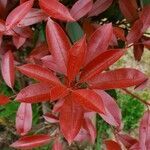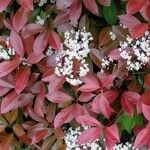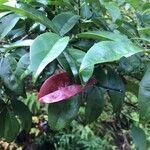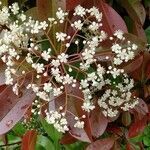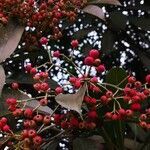Trees evergreen, 3–5 m tall, rarely to 7 m tall. Branchlets brown to grayish brown when young, grayish black when old, glabrous, with scattered brownish black orbicular lenticels; buds narrowly ovate, 3–5 mm, apex acuminate, rarely acute; scales dark brown, glabrous. Petiole 1–1.5 cm, glabrous; leaf blade initially reddish, elliptic, oblong, or oblong-obovate, 5–9 × 2–4 cm, thickly leathery, veins 10–18 pairs, both surfaces glabrous, base cuneate, margin with sparse, shallowly crenulate teeth, apex acuminate. Compound corymbs terminal, 6–11 × 7–12 cm, numerous flowered; rachis and pedicels glabrous. Pedicel 5–8 mm. Flowers 7–8 mm in diam. Hypanthium cupular, abaxially glabrous. Sepals triangular, 1–1.5 mm, apex acute. Petals white, obovate, 2–3 mm, adaxially white tomentose near base, base shortly clawed, margin revolute, apex obtuse. Stamens 20, nearly as long as or slightly shorter than petals. Ovary pilose apically; styles 2, rarely 3, basally free or connate; stigma capitate. Fruit red, obovate or ovoid, ca. 5 mm, glabrous. Fl. Apr–May, fr. Sep–Oct.
More
Plants 20–50 dm. Leaves persistent; petiole 10–30 mm, glabrous; blade elliptic to elliptic-obovate or elliptic-oblong, 5–9 × 2.5–5 cm, coriaceous, base cuneate, margins crenate-serrulate, lateral veins 10–15(–18) pairs, apex abruptly acuminate, surfaces glabrous. Inflorescences 4–10 cm diam. Pedicels without lenticels. Flowers 7–8 mm diam.; petals obovate, 2–3 mm, adaxially white-tomentose proximally.
A small tree. It has a crown which is narrow and domed. The leaves are bright red when new but become green. The flowers are small and white. They occur in clusters. The fruit are small and fleshy. They are red and ripen to black.
